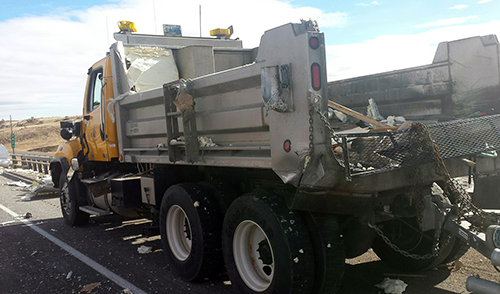- Home
- Administration
- Aeronautics
- Business with WYDOT
- Construction Projects
- Driver License and Records
- Economic Stimulus Projects (ARRA - TIGER)
- Engineering and Technical Programs
- Fuel Tax
- Highway Safety
- Human Resources
- Manuals and Publications
- News and Information
- Permits
- Planning/Projects/Research
- Titles, Plates and Registration
- Travel
- Trucking / Commercial Vehicles
- Vehicle Business Regulation
- Wyoming Highway Patrol
- Search
- Sitemap
Move Over law will help protect more WYDOT employees
April 23, 2018
 Motorists will soon have to move over for maintenance, construction and utilities workers and vehicles when traveling on Wyoming’s interstates and highways.
Motorists will soon have to move over for maintenance, construction and utilities workers and vehicles when traveling on Wyoming’s interstates and highways.
Starting July 1, 2018, Wyoming’s Move Over law will now include those workers in addition to emergency responders such as the Wyoming Highway Patrol. The state Legislature approved the changes to the Move Over law during this past legislative session.
“The Move Over bill is an important piece of legislation that will help protect our maintenance, construction and utility crews that work alongside Wyoming’s highways,” said Gregg Fredrick, WYDOT chief engineer. “This will help to provide a safe place to work so that they can return home to their families every day.”
The new Move Over law requires motorists to do what they currently do when encountering an emergency vehicle that has pulled over.
When a construction, maintenance or utility vehicle is stopped on a road with two or more lanes in the same direction, motorists must move to the farthest lane away from the stopped vehicle.
On a two-lane road where speeds are 45 mph or greater, motorists must slow down to 20 mph below the posted speed limit. Motorists can be fined $235 for failure to move over. WYDOT is currently making signs about the new requirements as a way to help educate the public.
Tony Avila, area foreman for the Wyoming Department of Transportation, knows firsthand how vital the new Move Over law is for WYDOT workers who help keep the roads safe for the traveling public.
Over the course of his 37 and a half years at WYDOT, Avila and his crew have experienced around 40 incidents where their WYDOT vehicles were sideswiped, mirrors were damaged or vehicles rear ended. WYDOT has advanced signs alerting motorists of upcoming construction, changes in traffic patterns and reduced speed limits.
Out of the 40 incidents, 10 required medical attention for Avila’s crew members and one person never returned but did not sustain life threatening injuries.
“There were a lot of near misses where I had to move quickly into the ditch or they had to,” Avila said.
One near miss occurred during a past winter when Avila was helping a motorist who slid off the road into the ditch. The two were standing behind Avila’s plow truck. Avila was getting information to relay to Patrol when another car lost control. The other vehicle ended up rear ending Avila’s plow truck.
“I had to grab the guy’s arm and yank him off the road,” Avila said. “The vehicle would have crushed us. After the incident, the vehicle never stopped and went on its way.”
Avila, who testified before the legislature about enhancing the Move Over law, said he’s pleased it passed.
“We now have to educate people about the importance of moving over,” Avila said. “It’s hard when you have to call the families of crew members who were taken to the hospital for injuries. My worst nightmare is calling a family and telling them it’s much worse. I want all my workers to go home safe.”
Although the law has always covered emergency responders, Patrol has still experienced collisions from inattentive drivers who failed to move over.
Since 2016, vehicles have hit 12 patrol cars stopped at the roadside. As a way to help remind the public about the importance of moving over, some Patrol cars have a decal on the rear window that says “Save a Life, Move Over.”
“Moving over for emergency responders and construction, maintenance and utility workers is so vital,” said WHP Sgt. Momen Elazizi. “It’s just a common courtesy to move over for anyone stopped at the side of the road. It ensures everyone gets home safely.”
Often times, driving distracted could be the reason people don’t see emergency responders or workers on the side of the road. Motorists need to put all distractions away, especially cell phones, and just concentrate on driving.
“If you’re a passenger in a vehicle and the driver is not moving over, please remind them to move over,” Elazizi said.
For additional information about this news release, contact Aimee Inama, senior Public Affairs specialist, at (307) 777-4013, or Sgt. Kyle McKay, Wyoming Highway Patrol Safety and Training Division, at (307) 777-4306.








